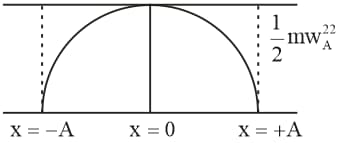Energy in SHM
Energy in SHM: Overview
This topic covers concepts such as Energy in SHM, Potential Energy in Terms of Displacement in SHM, Potential Energy in Terms of Time in SHM, Maximum Potential Energy in SHM, etc.
Important Questions on Energy in SHM
A particle of mass oscillates in Simple Harmonic Motion between points and , the equilibrium position being . Which of the following graphs represents the variation of its potential energy with respect to its position?
A particle executing SHM with an amplitude . The displacement of the particle when its potential energy is half of its total energy is
If is the displacement of the particle from the mean position, the total energy of a particle executing simple harmonic motion is
The total energy of the particle executing Simple Harmonic Motion is
Graph of kinetic energy in terms of displacement in :-
(i) At what displacement of particle executing has maximum kinetic energy.

Which of the given is graph of the square of cosine function?
A particle is executing simple harmonic motion with a time period T. At time t = 0, it is at its position of equilibrium. The kinetic energy - time graph of the particle will look like:
The kinetic energy of a particle executing S.H.M. is when it is at its mean position. If the amplitude of oscillations is , and the mass of the particle is , then the time period of the oscillation is
Which of the following is correct about Simple Harmonic Motion (SHM) along a straight line?
For a simple pendulum, a graph is plotted between its kinetic energy () and potential energy () against its displacement . Which one of the following represents these correctly?
(graphs are schematic and not drawn to scale)
A point particle is acted upon by a restoring force The time period of oscillation is when the amplitude is The time period for an amplitude will be:
The ratio of kinetic energy at a mean position to potential energy at of a particle performing is
is the potential energy of an oscillating(SHM) particle and is the force acting on it at a given instant. Which of the following is correct?
(Given is displacement of the particle)
A particle of mass oscillates with simple harmonic motion between points and , the equilibrium position being at . Its potential energy is plotted. It will be as given below in the graph,
A block of mass tied to a long spring of spring constant is at rest on a horizontal frictionless surface. The block is pulled through a distance from its equilibrium position and released. Then the total energy of the block when it is at a distance from the equilibrium position is
The potential energy of a simple harmonic oscillator of mass at its mean position is . If its total energy is and amplitude is , then its time period is
The and of a particle executing simple harmonic motion with amplitude has ratio , then its displacement is,
At what time will be equal to half of the total energy in SHM of time period .
A simple pendulum of length has mass and it oscillates freely with amplitude . At extreme position, its potential energy is (= acceleration due to gravity)
Obtain an expression for potential energy of a particle performing What is the value of potential energy at
(i) mean position
(ii) extreme position?
